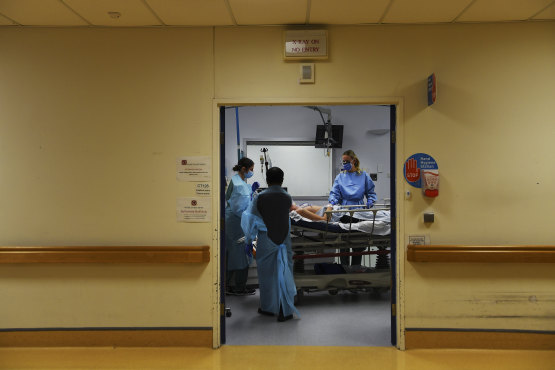This was published 3 years ago
One in 10 COVID patients in hospital as system plans for surge
By Lucy Carroll and Mary Ward
Sydney’s hospitals are standing by to mobilise COVID-19 surge plans in preparation for the possible influx of people needing urgent care, as the number of cases in ICU climbs.
More than 10 per cent of the state’s 395 cases are now in hospital, prompting the Australian Medical Association to warn that the system will be overwhelmed if NSW eases Greater Sydney’s lockdown before spread of the highly transmissible Delta variant is contained.

St Vincent’s Hospital is preparing its surge capacity in light of a possible jump in cases.Credit: Kate Geraghty
On Thursday, Chief Health Officer Kerry Chant revealed 40 COVID-19 patients were now in hospital, with 11 of those in ICU – an increase of four overnight.
Seventeen of the hospitalised patients are under the age of 55 and, of those, 10 are under 35.
Of the 11 people in ICU, one is in their 30s, one is in their 50s and the remainder are in their 60s and 70s. Three of the ICU patients are ventilated.
Associate Professor Gail Matthews, head of infectious diseases at St Vincent’s Hospital in Darlinghurst, said hospitals across Sydney were watching the situation “very carefully” and will need to be placed to respond to a possible surge in cases over the next few weeks.
“We do have a number of people in NSW hospitals who are severely unwell and it’s not surprising because we know COVID-19 can do that,” she said.
Dr Matthews said hospitals were constantly reviewing ICU beds, the number of negative pressure rooms available and COVID-19 specific ward availability.
“A part of the population over age 70 having had one vaccine dose may be providing some protection for older groups. I’m not convinced the Delta is more virulent but it is certainly more transmissible [than previous variants of the virus]”.
Grattan Institute health economist and former health bureaucrat Stephen Duckett said a lack of vaccination coverage meant NSW was in the same position it was when COVID-19 first entered the community over a year ago.
“Back then, there was a huge risk that if you opened up while the virus was circulating it would get out of control, overwhelm the hospital system and cause higher death rates,” he said.
“Really, relative to 2020 our situation has got worse: the virus is both more transmissible and more dangerous.”
Dr Duckett said Australia had learnt over the past year that “the right health decision turns out to be the right economic decision”.
The last time someone was in ICU in their 30s was during the Crossroads Hotel cluster in July 2020. However, during that outbreak and more recent Avalon and Berala clusters, the number of COVID-19 patients in ICU was not as high.
Dr Matthews said the absence of COVID-19 in the community in the past months meant cases in hospital were “a stark reminder that this can be a severe disease and a proportion of people will end up in hospital. It can be forgotten that this can be a serious infection”, she said.
The Australian Medical Association called for NSW to extend its lockdown for as long as is needed to eliminate the spread of the Delta variant in Greater Sydney, expressing concern about the strain on hospitals if cases multiply. President Omar Khorshid described an elimination strategy as Australia’s “secret to success with COVID-19”.
The comments came after Health Minister Brad Hazzard suggested Sydneysiders would need to live with the virus when the city’s lockdown ended on July 16. Premier Gladys Berejiklian has since clarified the date for lockdown to lift is not set, although the health advice is that easing restrictions next week remains possible.
Stay across the most crucial developments related to the pandemic with the Coronavirus Update. Sign up to receive the weekly newsletter.